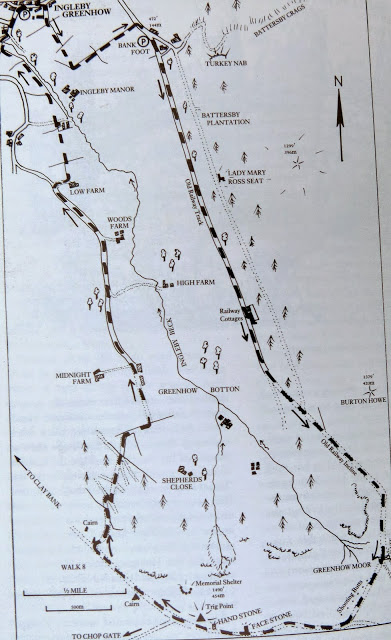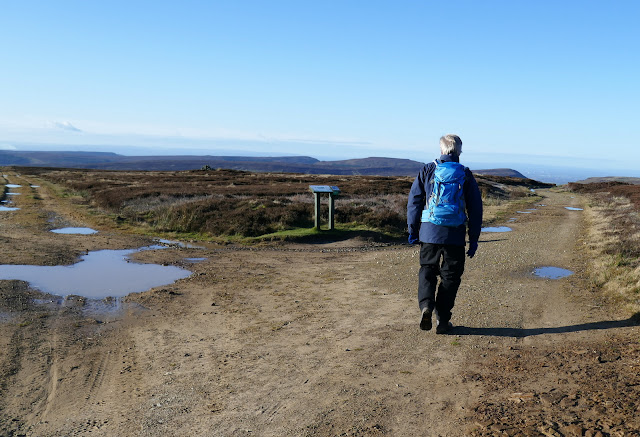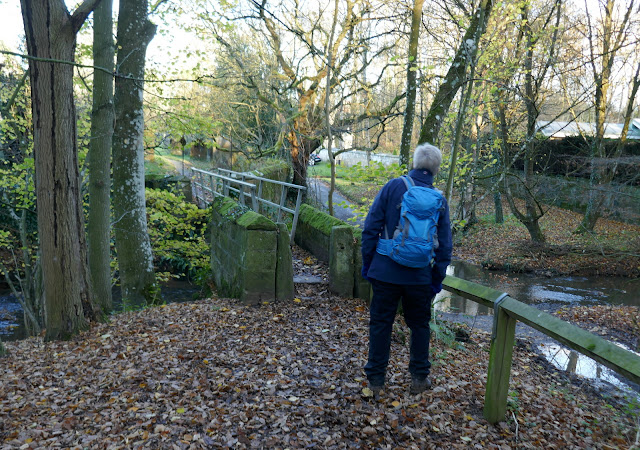8.5 miles Sunny but cold
We parked the cars in Ingleby Greenhow in the overflow car park for the Dudley Arms and walked back to the main road and followed it in the direction of Kildale.
Tom Scott Burns notes in his Walker's Guide to the Cleveland Hills that the name Ingleby has been written in various ways over the years, including Angleby, Engelbi, Yngleby and Yngylby.
The route parts from the road alongside a newly built house where we followed a narrow path between houses onto meadows. Over to the right we could see Ingleby Manor which is now holiday accommodation.
The Old Vicarage in Ingleby Greenhow
Turn right off the road at the footpath sign
A narrow footpath between the houses....
.... soon emerges onto meadows
Ingleby Manor over to our right
We crossed several sheep fields to reach Bank Foot Farm, situated under Turkey Nab. Tom Scott Burns says in the Walker's Guide that in 1729 William Parkin was hung from gallows mounted on Turkey Nab for murdering his brother-in-law at Great Broughton.
Follow the path through fields
Even a ram in harness has to stop and eat occasionally
Bank Top Farm and Turkey Nab beyond
Bank Top Farm
The Grim Sheeper
At Bank Foot Farm we paused to pay our respects to The Grim Sheeper before turning on to the track following the old railway bed. We now had an easy walk of about 2.5 miles passing a row of railway cottages and eventually reaching the incline bottom where we paused to read the information board.
Walking along the old railway track
We meet the Incline Railway trail
Pictures from the Information Board at Incline Bottoms
Tom Scott Burns tells us that the old railway was completed in 1861 and leads to the foot of the incline bank where the trains were loaded with ironstone. The incline reaches a maximum gradient of 1 in 5 and a brake drum house was situated at the top. Three empty wagons were hauled by steel ropes as three loaded wagons descended, an operation which took 3 minutes at a speed of 20mph, regulated by the drum house.
Leaving the new sign we started our long climb up the old incline railway. We climbed steadily and passed by some old graffiti of a man wearing a stovepipe hat with a bird in front of his face. TSB suggests that this is a satirical caricature carved by a railway navvy in a moment of inactivity.
Leaving the new sign we started our long climb up the old incline railway. We climbed steadily and passed by some old graffiti of a man wearing a stovepipe hat with a bird in front of his face. TSB suggests that this is a satirical caricature carved by a railway navvy in a moment of inactivity.
Looking back down to Greenhow Botton from the Incline
Old graffitti
Clive admiring the graffitti
"Is it still flashing....?"
Reaching the top we found a sheltered spot to enjoy our coffee and scones in the sun. Refreshed, a short stroll took us to another information board at the site of the old drum house, which was dismantled in 1941. We were pleased to see that the cast iron model of the incline top was finally in place and paused to examine it properly.
Ruins of he old drum house
Cast iron model of the cluster of buildings that once graced Incline Top
Information Board
After reading the information board we followed the railway bed, which officially closed on 13th June 1929 and now makes a nice 11 mile path to Farndale, Westerdale and Rosedale. Turning off the railway at a broad track we joined a trail to Cockayne Head and Botton Head, which is also part of the Cleveland Way.
As we walked this trail we came to two old boundary posts, the first known as The Face Stone, is mentioned in a 1642 document for the Helmsley Estate, and the second, showing a carved hand near to Round Hill dates from 1711. Near the Hand Stone is the trig point at Botton Howe which is located on a Bronze Age burial mound at 1490 feet, the highest point on the North York Moors.
Face Stone
Back of Face Stone, we can make out 'CHJ 1892'
Trig Point at Botton Head
We can just make out the hand of the Hand Stone through the lichen
We walked back to the wide path and continued walking across Urra Moor, which according to TSB derives from the Old English 'horh' meaning 'filth'! Eventually we came to a new signpost where we left the Cleveland Way to bear right on an indistinct path that drops off the moor down Jackson's Bank and into Greenhow Plantation. This track has been used by motorcycles and is difficult to negotiate in places.
We reached the bottom of Jackson's Bank at the curiously named Clogger's Hall, on the OS map - nothing to be seen, and crossed Greenhow Botton to walk towards New Sheepfold Farm.
Over to the right we could see the incline railway while ahead of us Roseberry Topping appeared in the distance. A mile or so on and several farms further, the tarmac lane took us to Low Farm.
Ram at New Sheepfold Farm
Jacob's Sheep at New Sheepfold Farm
Diversification into holiday accommodation
We could do with a hot tub today!
Our path turned left just before the farm buildings of Low Farm, into fields which we crossed one after another, at first following a newly fenced path but later the unseen rights of way by aiming for the yellow right of way signs on each field boundary.
Eventually we reached the bridge over Ingleby Beck and we crossed into the churchyard of St Andrew's beyond it.
Eventually we reached the bridge over Ingleby Beck and we crossed into the churchyard of St Andrew's beyond it.
Weather vane at Low Farm
Wet fields to cross
We leave the sheep fields...
... and descend on slippery slabs to Ingleby Beck
Across the bridge to...
... St Andrew's Church
TSB says that the original church was granted to the abbots of Whitby in 1143 by Adam de Ingelby and still retains traces of Norman work. The tower's two small bells are the oldest in Yorkshire, cast by Johan Copgrove 600 years ago.
Unfortunately Coronavirus means the church is locked and the pubs are closed and so we take off our boots and head for home, thankful that the countryside at least, is still open to the walker.























































No comments:
Post a Comment